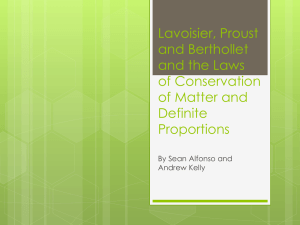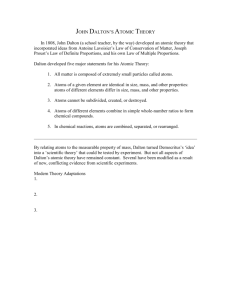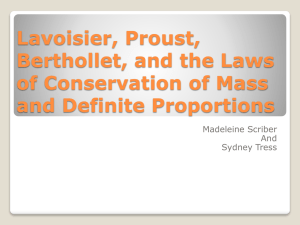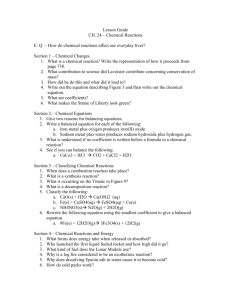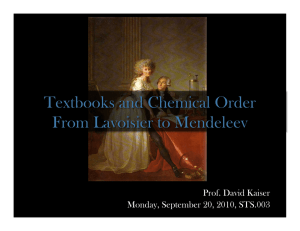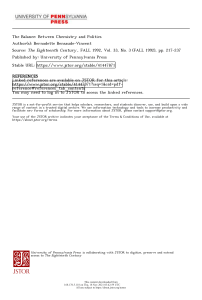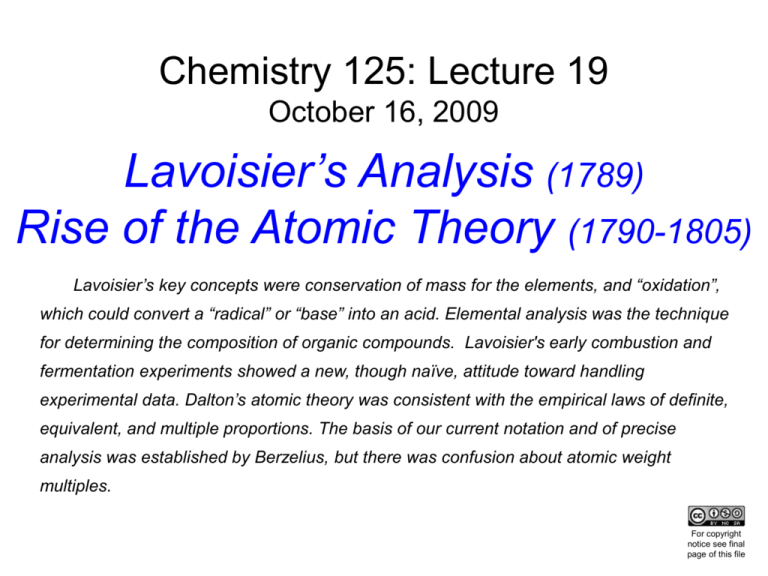
Chemistry 125: Lecture 19
October 16, 2009
Lavoisier’s Analysis (1789)
Rise of the Atomic Theory (1790-1805)
Lavoisier’s key concepts were conservation of mass for the elements, and “oxidation”,
which could convert a “radical” or “base” into an acid. Elemental analysis was the technique
for determining the composition of organic compounds. Lavoisier's early combustion and
fermentation experiments showed a new, though naïve, attitude toward handling
experimental data. Dalton’s atomic theory was consistent with the empirical laws of definite,
equivalent, and multiple proportions. The basis of our current notation and of precise
analysis was established by Berzelius, but there was confusion about atomic weight
multiples.
For copyright
notice see final
page of this file
Elementary Treatise
of Chemistry
PRESENTED IN A NEW ORDER
AND ACCORDING TO MODERN DISCOVERIES
With Figures
New Order
1) Ideas
Doctrine
2) Words
Nomenclature
3) Operations
Facts
1789
Facts:
Analysis
Analysis
Traité
Élémentaire
de Chimie
(1789)
The word gas is thus for us a generic name that
designates the ultimate degree of saturation of whatever
substance by caloric.
We have given to the base of the portion of air
that supports respiration the name of oxygen,
Since
besides
the chemical
it has
been
properties
shown
toofenter
the part
alsoofinto
atmospheric
nitric acid
deriving
it from
two
Greek
words
(oxus),
aircompounds;
that
does &
not
sosupport
onetocould
respiration
be
just as
were
properly
not well
known,
it the
acid,
(geinomai),
to
cause
toname
be,
we find
ourselves
forced
give
a name.
Nothing
seems
more
wenitrigen
were
content
principle.
tofact
deduce
Ultimately
thethe
name
had
ofgeneral
its
to base
reject
from
a name
the of
one of
most
properties
convenient
tobecause
us
thanin
hydrogen,
that
iswe
to say,
the
generating
property
which
conveyed
ofbase
itsfrom
gas
to
a systematic
take
the
life
idea,
of combining
animals
&
to
breathed
this
is forming
acids
by
with
most
principle
of water,
(hydor)
water,
&decided
fromthat
, avoid
it :this
so
risk
have
of fooling
ourselves
itshall
azote,
from
by
adopting
the
Greek
the
privative
names
substances.
thus
call
oxygen
gas
thethis
(geinomai)
, towe
cause
tonamed
be.We
We
shall
call
the
combinate
of
and
azotic
gas,
which
expresses
only
a fact,
,azote
and
from
hydrogen
(zoe)
life,
thus
the
partor
of
of this
base
caloric.
principle
withcombination
caloric
gas,
&with
theunbreathable
word
hydrogen
alone
airbetter
would
a property,
bebase
azotic
that
gas.same
of taking
of animals
that
will stand
for the
of this
gas, the
the life
radical
of water.
breathe this gas.
Oxy-gen
Caloric
FACT
+
Base or
THEORY
Radical
WORD
Acid
Gas
?
Lavoisier's
Compound
Radicals
Scheele
Acids
Oxidation States
Radical
1°
"oxide"
2°
"-ous" acid
3°
"-ic" acid
4°
"oxygenated
-ic" acid
Risky Prediction
Air
Supply
H2O
Collector
CO2
Collector
H2O
Collector
Lamp
Oil
Supply
Elemental Analysis by Oil Combustion
Everyone knows how wine,
cider and mead are made…
How to analyze a
substance that will
not burn cleanly?
e.g.
grape
sugar
CO2
Absorption by
NaOH soln.
Foam
catcher
H2O
Absorption
by CaCl2
any
other
Gas
Sugar/Yeast/Water
Plate X: Fermentation Apparatus
Fermentation
it can furnish a means
of analyzing sugar
I can consider the materials
subjected to fermentation
and the products of fermenOxidation
tation as an algebraic
had failed with
equation; and by in turn
Air
supposing each of the
Oxygen
elements of this equation to
Sulfuric Acid
be unknown, I can derive a
Mercuric Oxide
value and thus correct
etc.
experiment by calculation
because of incomplete
and calculation by expericombustion (charring)
ment. I have often profited
from this way of correcting
the preliminary results of
my experiments.
72 grains = 1 gros
8 gros = 1 ounce = 28.35 g
Lavoisier’s
Bookkeeping
Ultimate
Proximate
Proximate
Lavoisier’s
Bookkeeping
Ultimate
Lavoisier’s
Bookkeeping
before
after
157
103
144 cu. in. (100 grains) Carbonic Gas
380 cu. in. (13.7 grains) Flammable Gas
313
9.4
28 grains Carbon
from 28 gr. C
(modern theory)
1.38 g
Water
Red-hot Glass Tube
Hydrogen Generator
Water (less
Water85.7 grains)
?
Carbon + Water = Carbonic Gas + "Hydrogen"
28 gr.
+ 85.7 gr.
=
100 gr.
+
13.7 gr.
"I have thought it best to correct by calculation
and to present the experiment in all its simplicity."
!
Traité
pp. 88-92
Lavoisier Contributions
Apparatus
Quantitation
Mass
volume
Clarity
Facts
Elements
Conservation
of Mass
Ideas
Oxidation
Substances
Radical/Acid
Reactions
Salts
Words
Meaningful Names
Element - Oxidation State - Salt Composition
-ous, -ic, -ide, -ite, -ate
Lack of Imagination
[Chemistry's] present progress,
however, is so rapid, and the facts,
under the modern doctrine, have
assumed so happy an arrangement,
that we have ground to hope, even
in our own times, to see it approach
near to the highest state of perfection of which it is susceptible.
Lavoisier Guillotined May 8, 1794
Age 50
"Il "It
ne took
leur a"The
fallu qu’un
them
only
Republic
has
moment
pour
faire
an
instant
to
make
no
need
of
geniuses.”
tomber cette tête, et
this head fall,
cent années peut-être
But
all
of
his
equipment
but
a
hundred
years
ne suffiront pas pour
may
not
suffice
to
(including
80
pounds
of mercury)
en reproduire une
reproduce
one like
was
seized
forit."
The People.
semblable."
Boyle Lavoisier
√
√
John Dalton
amateur meteorologist
1801
Why do gases
of different density
remain mixed rather
than stratifying?
Continental European
scientists proposed
that different gases
attract one another.
"the atoms of one kind did not repel the atoms of another kind"
“Heat Envelope”
Match
Repulsion
Mismatch
Reduced
Repulsion
Atom
Substitutes
homorepulsion
for
heteroattraction
Atoms Explain:
Definite Proportions
Pure compounds always have the
same weight ratio of their elements.
Equivalent Proportions
=
If a parts of A react with b parts of B,
and a parts of A react with c parts of C,…
and d parts of D react with b parts of B,
then d parts of D react with c parts of C.
Multiple Proportions
If two elements form several compounds,
their weight ratios are related by simple factors.
Definite Proportions?
NON!
metal alloys
natural "organic" materials
Claude Louis BERTHOLLET
(1748-1822)
OUI !
"chemicals"
Joseph Louis PROUST
(1754-1826)
Multiple Proportions
integral values consistent with simple atomic ratios
Oxides of Carbon
Carbonous Acid (1789)
%err
%C
%O
O/C
Rel.
of (O/C)
44
56
1.27
[1]
-5
2.57 2.02
~2
Carbonic Acid (1801)
28
72
Great scientists focus on the key factors despite errors.
(Greatness : Key :: Chicken : Egg)
vs. modern
-4
%err
%N
%O
O/N
Rel.
of (O/N)
Nitrous Oxide (1810)
63.30
36.70
0.58
[1]
-2
Nitrous Gas (1810)
44.05
55.95
1.27
2.19
~2
+11
Nitric Acid (1810)
29.50
70.50
2.39
~4
4.12
+11
Oxides of Nitrogen
vs. modern
Genealogy Top
Berzelius etc.
√
Jöns-Jakob
Berzelius BERZELIUS
(1779-1848)
Organic & Mineral
Analysis
2000 compounds in 6 years!
Good Atomic Weights
Textbook
(1808)
for 50 elements!
Electrolysis
Dualism
(double decomposition)
Teaching, Writing
& Editing
Notation for
Composition
Notation for
Composition
Alchemy
Dalton
Berzelius
1774 Symbols
Chemical
Symbols
of 1774
(Sweden)
H N C O P S Mg Ca
Na K Sr Ba Fe Zn Cu Pb
Ag Pt Au Hg
Chemical
HO HN NO HC OC
“When onlySymbols
one combination of two
NO
CO
bodies
can beNO
obtained,
it mustCH
be presumed
becombinations
aof
binary1774
one, are
unless
some
“When to
two
observed,
(Corresponding Berzelius Symbols)
2
2
2
2
2
2
2
2
3be appear
3 to the
3 a binary
3H
other
cause
contrary.”
they
must
presumed
to
be
NO
SO
SH
C
3
3
3
3
and a ternary… When three…a binary,
“When four…one binary, two ternary,
and the other two ternary. ”
and one quarternary, &c.
(Sweden)
Dalton’sNotation
Logic
Berzelius
(1811)
Dalton Notation
Latin (international)
(1808)
Analytical (NOT structural)
http://webserver.lemoyne.edu/faculty/giunta/dalton.html
Abbreviations:
Dots denote O atoms
= KO CrO3
Didn’t catch on
14O3 (“acid” as anhydride)
Benzoic should
be H10Cdenote
Superscripts
numbers of atoms
End of Lecture 19
Oct. 16, 2009
Copyright © J. M. McBride 2009. Some rights reserved. Except for cited third-party materials, and those used by visiting
speakers, all content is licensed under a Creative Commons License (Attribution-NonCommercial-ShareAlike 3.0).
Use of this content constitutes your acceptance of the noted license and the terms and conditions of use.
Materials from Wikimedia Commons are denoted by the symbol
.
Third party materials may be subject to additional intellectual property notices, information, or restrictions.
The following attribution may be used when reusing material that is not identified as third-party content:
J. M. McBride, Chem 125. License: Creative Commons BY-NC-SA 3.0



